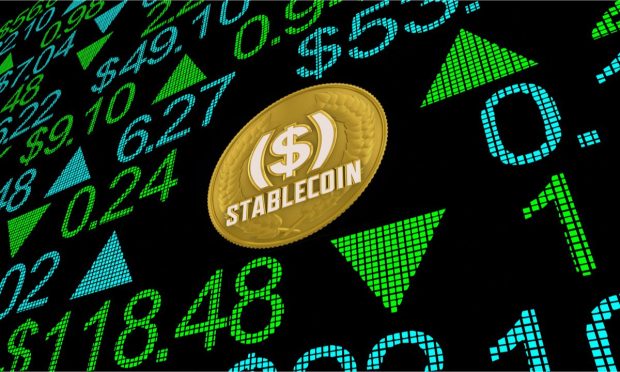Stablecoins’ Wobbly Dollar Pegs Add to Crypto Market Chaos

A pair of stablecoins broke the buck over the last 24 hours as inflation-fueled economic worries fueled a broader crypto market collapse that saw bitcoin fall below $24,000.
A brand-new, non-fiat-backed stablecoin, USDD, depegged overnight, dropping briefly about 2.5 cents below that dollar before working back up to a few hundredths of a cent below $0.99.
And the top stablecoin, Tether’s USDT, dropped briefly to $0.9975 on the morning of June 13, before popping up to $0.9987 — and while that’s small fractions of a cent, it’s particularly noticeable in light of the recent collapse of the terraUSD stablecoin, which took $45 billion of investors’ money when it and a sister-coin used to maintain its dollar peg suffered a run in the second week of May.
See also: TerraUSD’s Price Collapse Shows Vulnerability of Dollar-Pegged Cryptos
Tether Wobbles
Of the two, Tether is more concerning because of its size and prominence, but the actual cause and effect is less so.
Tether, the largest stablecoin with a market cap of $72 billion, has long faced concerns that the cash and investments reserve backing its peg were not always 100% backed — it paid $60 million to settle lawsuits by the New York Attorney General and Commodity Futures Trading Commission (CFTC) last year on this issue — and has been criticized for have too little fiat currency and too much insufficiently liquid investments like corporate paper in its reserves.
Read more: Tether Breaks Buck as Stablecoin Panic Spreads
It briefly depegged on May 12 as terraUSD was collapsing, and it has been trading very slightly under the dollar since then. But that has generally been above $0.999.
In addition, Tether’s market cap dropped about $10 billion around that time. A fair chunk of that went to Circle’s USDC — backed 100% by dollars and Treasuries — which has been trading a few hundredths of a cent above the dollar since terraUSD’s collapse. It’s market cap rose about $6 billion to $54 billion at the time.
But that seems to have been related more to an investment parent company Tether made in a centralized lending protocol, Celsius Network, that halted withdrawals over the weekend amid growing speculation that it’s insolvent. For its part, Tether has insisted that it made the investment with other funds — not its reserves.
Also read: Bitcoin’s Potential as ‘Digital Gold’ Loses Luster as Price Plummets
USDD Drops the Ball
The more worrying of the two from a circumstances perspective is USDD, an algorithmic stablecoin that uses an arbitrage system similar to terraUSD.
USDD launched on May 5 — an inauspicious time as terraUSD began to unravel on May 9, collapsing completely a week later along with its peg-partner token, Luna, which was really only used in a DeFi platform offering an eyebrow-raising 18% yield.
Mike Novogratz, CEO of crypto investment bank Galaxy Digital and a widely respected crypto investment figure, referred to that at an industry conference over the weekend, warning investors to “fight the impulse to be so greedy” and adding, “when ecosystems [grow] real fast, there’s a reason for it. Know what you are investing in. You don’t get 18% for free.”
The coin USDD uses as an arbitrage partner, Tron (TRX) has a more robust ecosystem behind it, with a five-year history and well-known founder at the head of its Tron Foundation, Justin Sun — best known for paying $4.6 million at a charity auction for a lunch with Berkshire Hathaway CEO Warren Buffet in 2019, only to postpone at the last minute due to what he said was illness and a number of industry publications and insiders speculated was pressure from China’s government.
While TRX — the No. 14 cryptocurrency — did drop steeply, it’s 16% decline was in line with virtually all of the 50 largest cryptocurrencies.
The Tron DAO Reserve that oversees the stablecoin has pumped $700 million into stabilizing USDD, and Sun has said he’ll put another $2 billion in if needed.
The Time is Now
All of this could well push the already growing calls for quicker action on stablecoin regulation that the Biden Administration seems to be gunning for, with proposals not due until September.
“I’m going to go out on a limb and say we get stablecoins done this year,” said Sen. Pat Toomey (R-Pa.) at the Consensus Crypto Conference in Austin over the weekend, according to CoinDesk. “We’re going to need to have regulatory certainty about that. I know the [Biden] administration is interested in doing something in this space.”
While that could run into midterm elections logjam, there is increasingly broad bipartisan support for getting stablecoin regulation out the door before broader crypto regulations that will very likely wait until 2023.
At the same show, Sen. Kirsten Gillibrand (D-New York), said a stablecoin bill might be more realistic this year because it’s seen as more “urgent,” adding “we just had a meltdown.”
Shiela Bair, a former chair of the U.S. Federal Deposit Insurance Corporation, writing in the Financial Times on June 10, called for a quick stabelcoin oversight regime based on the Securities and Exchange Commission’s (SEC) regulatory model for government money market funds, which she called “tailor-made for stablecoin issuers.”
Sign up here for daily updates on all of PYMNTS’ Crypto coverage.
